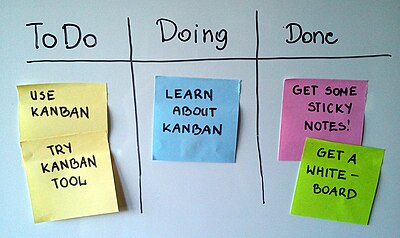Kanban board
A kanban board is one of the tools that can be used to implement the Kanban Method for a project.
Kanban boards are perceived as a variation on traditional kanban cards. Instead of the signal cards that represent demand or capacity, the board utilizes magnets, plastic chips, colored washers or sticky notes to represent work items.[1] Each of these objects represents an item in a production process as it moves around the board. Its movement corresponds with a knowledge work or manufacturing process.[2] At its simplest, the board can be divided into three sections: "waiting", "work in progress" and "completed work". Complex kanban boards can be created that visualise the flow of work across a value stream map.[3] Employees move cards to the section on the board that coincides with the activity it represents.[4]

Application
Kanban can be used to organize many areas of an organisation[5] and can be designed accordingly. The simplest kanban board consists of three columns: "to-do", "in progress" and "done",[6] while some additional detail such as WiP limits are needed to fully support the Kanban Method.[7] Business functions that use kanban boards include:
- Kanban board for software development team. A popular example of a Kanban board for agile or lean software development consists of: Backlog, Ready, Coding, Testing, Approval, and Done columns. It is also a common practice to name columns in a different way, for example: Next, In Development, Done, Customer Acceptance, Live.[8]
- Kanban for marketing teams[9]
- Kanban for HR teams[10]
- Organisational strategy and executive leadership teams[11]
- Personal task management or "Personal Kanban"[12] as described and promoted by Jim Benson.[13]
- Audit teams[14]
Principles
- visualize workflow
- limit the number of tasks under "in progress"[15]
- pull work from column to column
- monitor, adapt, improve[16]
Notable tools
- Asana, with boards[17]
- Jira (software), provides kanban boards
- Trello, kanban-based project management
See also
References
- ^ Kanban Guide: Demand Scheduling for Lean Manufacturing, Compiled by Nilesh R Arora. Add Value Consulting Inc., India 2001, p. 11.
- ^ J. M. Gross, Kenneth R. McInnis: Kanban Made Simple—Demystifying and Applying Toyota's Legendary Manufacturing Process. Amacom, USA 2003, p. 50. ISBN 0-8144-0763-3
- ^ "On Setting Your Initial WIP Limits". The Agile Director. 2014-12-07. Retrieved 2015-06-08.
- ^ Kanban Guide: Demand Scheduling for Lean Manufacturing, Compiled by Nilesh R Arora. Add Value Consulting Inc., India 2001, p. 11
- ^ Leybourn, E. (2013). Directing the Agile Organisation: A Lean Approach to Business Management. London: IT Governance Publishing: 160–166.
- ^ H. Kniberg, M. Skarin: Kanban and Scrum making the most of both. C4Media, Publisher of InfoQ.com, USA 2010, p. 31.
- ^ Anderson, David J.; Carmichael, Andy (2016). Essential Kanban Condensed. Seattle, WA: Lean Kanban University Press. ISBN 978-0-9845214-2-5.
- ^ codeweavers. "Agile Design: Kanban with our Web Designers - Design, Process Updates | Codeweavers Blog | Staffordshire Software Development House". Codeweavers.net. Retrieved 2012-08-17.
- ^ J. Dager: Why you should use Kanban in Marketing?,http://business901.com/blog1/why-you-should-use-kanban-in-marketing/
- ^ "Kanban for Short Intense Projects: How We Used Kanban to Visualize Our Hiring Process Workflow and Make Our Lives Easier". Personal Kanban. 2011-01-19. Retrieved 2012-08-17.
- ^ "New Zealand Post Group – An Agile Executive!". Agile Business Management Consortium. 2013-12-02. Retrieved 2015-06-08.
- ^ Benson, Jim, and Tonianne DeMaria Barry. Personal Kanban: Mapping Work, Navigating Life. Modus Cooperandi Press, 2011.
- ^ Willeke, Marian HH. "Agile in Academics: Applying Agile to Instructional Design." Agile Conference (AGILE), 2011. IEEE, 2011.
- ^ "Agile and Internal Audit!". Agile Business Management Consortium. 2014-07-16. Retrieved 2015-06-08.
- ^ "Building Your First". Personal Kanban. 2009-08-23. Retrieved 2012-08-17.
- ^ J. Boeg, Priming Kanban,
- ^ "Asana Kanban boards". Asana. 2017-05-01.
